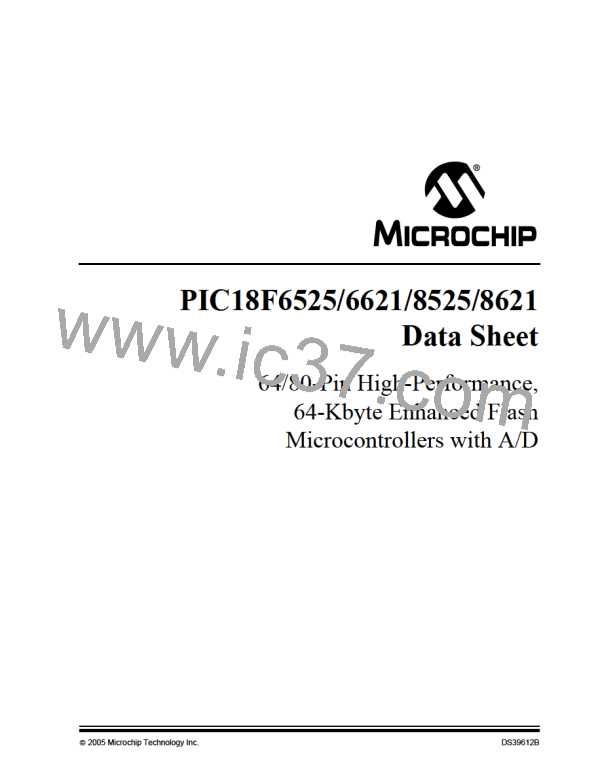PIC18F6525/6621/8525/8621
18.4.6
MASTER MODE
Note:
The MSSP module, when configured in
I2C Master mode, does not allow queueing
of events. For instance, the user is not
allowed to initiate a Start condition and
immediately write the SSPBUF register to
initiate transmission before the Start
condition is complete. In this case, the
SSPBUF will not be written to and the
WCOL bit will be set, indicating that a write
to the SSPBUF did not occur.
Master mode is enabled by setting and clearing the
appropriate SSPM bits in SSPCON1 and by setting the
SSPEN bit. In Master mode, the SCL and SDA lines
are manipulated by the MSSP hardware.
Master mode of operation is supported by interrupt
generation on the detection of the Start and Stop con-
ditions. The Stop (P) and Start (S) bits are cleared from
a Reset or when the MSSP module is disabled. Control
of the I2C bus may be taken when the P bit is set or the
bus is Idle, with both the S and P bits clear.
The following events will cause MSSP Interrupt Flag
bit, SSPIF, to be set (MSSP interrupt, if enabled):
In Firmware Controlled Master mode, user code con-
ducts all I2C bus operations based on Start and Stop bit
conditions.
• Start condition
• Stop condition
• Data transfer byte transmitted/received
• Acknowledge transmit
• Repeated Start
Once Master mode is enabled, the user has six
options.
1. Assert a Start condition on SDA and SCL.
2. Assert a Repeated Start condition on SDA and
SCL.
3. Write to the SSPBUF register initiating
transmission of data/address.
4. Configure the I2C port to receive data.
5. Generate an Acknowledge condition at the end
of a received byte of data.
6. Generate a Stop condition on SDA and SCL.
2
FIGURE 18-16:
MSSP BLOCK DIAGRAM (I C™ MASTER MODE)
Internal
Data Bus
SSPM3:SSPM0
SSPADD<6:0>
Read
Write
SSPBUF
SSPSR
Baud
Rate
Generator
SDA
Shift
Clock
SDA In
MSb
LSb
Start bit, Stop bit,
Acknowledge
Generate
SCL
Start bit Detect
Stop bit Detect
Write Collision Detect
Clock Arbitration
State Counter for
end of XMIT/RCV
SCL In
Bus Collision
Set/Reset S, P, WCOL (SSPSTAT),
Set SSPIF, BCLIF,
Reset ACKSTAT, PEN (SSPCON2)
2005 Microchip Technology Inc.
DS39612B-page 197

 MICROCHIP [ MICROCHIP ]
MICROCHIP [ MICROCHIP ]